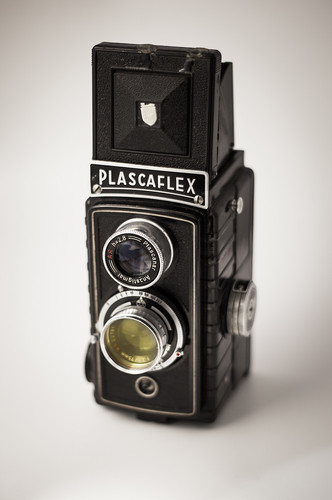Difference between revisions of "Plascaflex"
Hanskerensky (talk | contribs) m (Redirected Link URL to new site) |
Hanskerensky (talk | contribs) (Corrected description of Staeble lens on the Plascaflex PS 35, these are surely coated (red AR-designation) as seen on my own Plascaflex and numerous images on the web) |
||
| Line 12: | Line 12: | ||
* The '''Plascaflex V 45''' has an uncoated 75 mm f/4.5 Plascanar taking lens, and a three-speed [[Vario]] shutter, [[flash sync|synchronised]] for flash with a [[PC socket]]. At least in the Raluflex I, the lens is labelled '[[Steiner]] Plascanar', and the viewing lens is an f/3.2 'Plascanar Special'. | * The '''Plascaflex V 45''' has an uncoated 75 mm f/4.5 Plascanar taking lens, and a three-speed [[Vario]] shutter, [[flash sync|synchronised]] for flash with a [[PC socket]]. At least in the Raluflex I, the lens is labelled '[[Steiner]] Plascanar', and the viewing lens is an f/3.2 'Plascanar Special'. | ||
| − | * The '''Plascaflex PS 35''' has | + | * The '''Plascaflex PS 35''' has a coated 75mm f/3.5 Plascanar Anastigmat taking lens made by [[Staeble]], and a synchronised [[Prontor]] S shutter, with speeds 1 - 1/300 second plus 'B', with a self-timer. The viewing lens is an f/2.8 Plascanar. |
The camera's most unusual characteristic is the focusing magnifier stored in the bottom of the camera. In this same space an extra roll of film can be stored. | The camera's most unusual characteristic is the focusing magnifier stored in the bottom of the camera. In this same space an extra roll of film can be stored. | ||
Revision as of 07:04, 7 April 2019
| |||
| German TLR () | |||
|---|---|---|---|
| 35 mm | Contaflex | Flexilette | Optima Reflex | ||
| 3×4 | Pilot Reflex | ||
| 4×4 | Baby Rolleiflex (1931) | Baby Rolleiflex (1957) | Karma-Flex | ||
| 6×6 | Altiflex | Amplion Reflex | Brillant | Flektar | Flexo | Flexora | Flexora II | Flexora III | Foth-Flex | Ikoflex 1 | Ikoflex II | Ikoflex Ia | Ikoflex Ic Ikoflex Favorit | Karma-Flex | Mentorett | Montiflex | Peerflekta | Perfekta | Photina Reflex | Plascaflex | Reflecta | Reflekta | Reflekta II | Rica Flex | Rocca Automatic | Rocca Super Reflex | Rolleiflex | Rolleicord | Rollop | Superb | Superflex | Trumpfreflex | Vitaflex | Weltaflex | Wirgin Reflex | Zeca-Flex | ||
| 6×9 | Superfekta | ||
The Plascaflex is a TLR camera for 6×6 cm exposures on 120 film, made in 1952 by Potthoff & Co. (later Montanus Kamerafabrik) in Solingen, West Germany. The name probably refers to the bakelite-like polymer the camera body was made from. Potthoff was a plastic moulding company, and the Plascaflex was its first camera.[1] It was sold in Britain as the Amplion-Reflex by Amplion, a company which mainly made radios and gramophones. It was also sold as the Raluflex I (this may be a name variant specifically of the V 45 model; both the example pictured in McKeown and one on the Web have an f/4.5 lens)[1][2].
There were two models, offering different levels of specification:
- The Plascaflex V 45 has an uncoated 75 mm f/4.5 Plascanar taking lens, and a three-speed Vario shutter, synchronised for flash with a PC socket. At least in the Raluflex I, the lens is labelled 'Steiner Plascanar', and the viewing lens is an f/3.2 'Plascanar Special'.
- The Plascaflex PS 35 has a coated 75mm f/3.5 Plascanar Anastigmat taking lens made by Staeble, and a synchronised Prontor S shutter, with speeds 1 - 1/300 second plus 'B', with a self-timer. The viewing lens is an f/2.8 Plascanar.
The camera's most unusual characteristic is the focusing magnifier stored in the bottom of the camera. In this same space an extra roll of film can be stored.
There is also a Plascaflex Modell II, probably a later model. The lenses on this model are called Pluscanar; they are an f/3.5 taking lens and an f/2.8 viewing lens. The name Pluscanar was used on the metal-bodied cameras (the Delmonta and its name-variants) which replaced the Plascaflex in the mid-50s, but the Modell II has the same plastic body as the original Plascaflex models. It also has a Prontor SV shutter, with the same specification as the Prontor S above, but with switchable M- or X-synchronisation. The Atlantiflex Super appears to be similar to this model.[3]

|
| Plascaflex PS 35 image by Gerard Vogels (Image rights) |
Notes
- ↑ 1.0 1.1 McKeown, James M. and Joan C. McKeown's Price Guide to Antique and Classic Cameras, 12th Edition, 2005-2006. USA, Centennial Photo Service, 2004. ISBN 0-931838-40-1 (hardcover). ISBN 0-931838-41-X (softcover). p696-7.
- ↑ Raluflex I at Emtus Kamera Nachschlagewerk
- ↑ Atlantiflex Super with f/3.5 Pluscanar lens and Prontor S (not SV) shutter, in a past auction catalogue, in Swedish, by Auction2000
Links
- a Plascaflex model and variations description with pictures.
